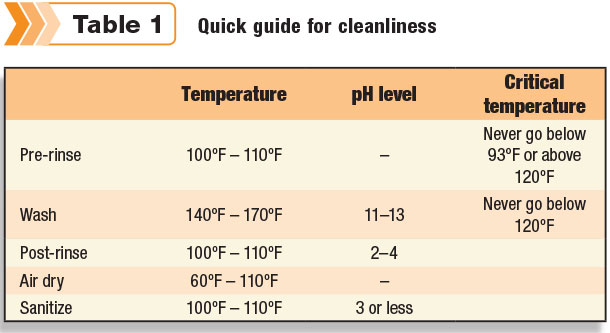Editor’s note: This article is part two in a three-part series on evaluating your hygiene protocols. Visit Are you saving money with hygiene? to read part one and Are your calves secure? 7 ways to make it so to read part three. It has been said, cleanliness is next to godliness. Nowhere on a dairy is this saying more true than in the maternity and calf areas. Providing a clean environment for our newborn calves can save us thousands of dollars in future treatments and medical expenses.
In our last article, “Are you saving money with hygiene?” from the April 1, 2016, issue of Progressive Dairyman, we discussed the importance of verifying cleanliness on your dairy. Now, we will focus on properly executing cleaning protocols.

Here are five steps that will help you:
1. Is it worth cleaning?
Before we dive into cleaning protocols, let us evaluate our equipment.
Items made of plastic are the hardest to clean. Any nicks, scratches or cracks will create a rough surface, which harbors and grows bacteria. Pay special attention to scratched plastic tube feeders; those also run the risk of irritating or injuring the calf’s esophagus. Over a period of time, plastic will deteriorate, so replace any items that have scratches, cracks or are just plain old.
You may also choose to design certain tasks to be executed using single-use tools to prevent contamination. Successful examples would be commercially available disposable colostrum bags or paper cups for navel dipping.
Whenever possible, use tools made of stainless steel for feeding your calves since those are the easiest to clean and sanitize.
2. Be aware of the labels
When was the last time you actually read the active ingredients on your cleaning agents? Do you know what personal protective equipment (PPE) is recommended? Are you mixing your ingredients in the right ratio, or are you guessing at it? Are you using the right agent for the right step in the process?
We all know how hard it is to get rid of bacteria once it is present in the facility, so it is important that you use the appropriate cleaning agent in the right pH range for a particular step, otherwise it may not be as effective as you think it is. Remember, cleaning agents aren’t created equal and neither is the pH of water across the U.S., so testing for the right pH is equally important.
3. Train the trainers
Cleanliness is 100 percent dependent on the people who implement it, so make sure the cleaning and sanitation protocols are clearly posted and, more importantly, those responsible for cleaning are properly trained. Here are the steps that will guide your hygiene towards healthy calves on your dairy.
STEP 1Rinse with lukewarm water
Make sure you rinse both the inside and outside of calf buckets, bottles, nipples, tube feeders and other feeding tools. Water temperature is critical on the first rinse of tools used to feed colostrum. Milk/colostrum proteins react to temperatures above 120°F by adhering to the surfaces, forming an invisible film and a perfect environment for bacterial growth.
Tools used for feeding colostrum are especially susceptible since colostrum contains higher levels of protein and should be rinsed at 100°F to 110°F. Do not use water below 93°F because that temperature is too cold to wash out fat, allowing it to collect on the surface.
STEP 2 Wash in hot, soapy water
Time to turn up the heat – always wash feeding equipment with hot water (140-160°F). For this step, an alkaline detergent is important in breaking up the remaining milk fat. Check that your solution of chlorinated cleaner or a combination of detergent plus bleach reads at a pH level between 11 and 13. The right pH breaks up the fat, and the chlorine helps in removing the protein.
Manual cleaning is a critical part of this step, so vigorously brush for one to two minutes to remove any organic matter from the surface.
Watch your temperature. If it falls below 120°F, the milk solids may reattach themselves and all of your hard work goes to waste.
STEP 3 Post-rinse with acid
Use lukewarm water (100-110°F) to remove the soap residue. Once the soap is gone, add acid sanitizer. Follow the label directions for proper water dilution. Check your solution with a pH paper strip or a pH meter to make sure it is staying in the two to four range.
The effect of acid sanitizer is twofold. One, it removes milk minerals and prevents them from accumulating on surfaces; and two, it lowers the surface pH, creating an environment that’s too acidic for bacterial growth.
STEP 4 Air dry thoroughly
Moisture provides bacteria with a growth environment. By allowing the calf-feeding tools to dry thoroughly, you are ensuring the next step of sanitizing will be effective. To ensure good drying, arrange your equipment on racks, but arrange them far enough apart to allow for good airflow. Avoid stacking buckets on top of each other until they are completely dry, and always keep feeding equipment off the floor to prevent contamination.
STEP 5 Sanitize
Two hours or less prior to feeding, sanitize everything one more time on both the outside and inside surfaces and allow time to dry. This second acid cycle ensures that any bacterial pockets that might have been hiding under a layer of moisture in Step #3 have been addressed, and it takes care of any contamination during the drying period.
A chlorine dioxide (ClO2) solution has become very popular for use during this step due to its effectiveness for Cryptosporidium parvum. It is an effective method provided you take the time to properly understand the correct concentrations, application and precautions.
4. Verify your effectiveness
Knowing your protocols are actually working is priceless. Fortunately, in the 21st century, we have methods and tools to test our effectiveness immediately and correct any shortcomings long before our animals start showing signs of poor hygiene. They include protein residue swabs and the ATP test luminometer.
- Protein residue swabs offer a cheap and quick way to check surfaces of bottles, nipples and tube feeders for protein residue without the need for an expensive luminometer (ATP meter). Simply swab the surface, return to its tube, release the chemical agent and then watch it change colors depending on the level of protein residues.
These swabs, while not measuring actual bacteria, allow for everyday low-cost verification of the effectiveness of cleaning protocols.
- ATP test luminometer is a highly sophisticated tool able to detect living organisms on feeding equipment. The adenosine triphosphate (ATP) is an energy molecule residing in the cells of all living things, including bacteria. Using a swab, sample the surface of your tube feeder, feeding bottle, nipple or bucket.
Return back to its tube, release the chemical agent and then place in the luminometer. A reading of estimated bacterial contamination follows. Luminometers are available for purchase to anyone, but are often offered as a service by your local veterinarian.
5. Practice
As former Green Bay Packers’ head coach Vince Lombardi once said, “Practice does not make perfect. Only perfect practice makes perfect.” We can be given the correct cleaning agents and protocols, but if we are not practicing our cleaning correctly then we are doing no good.
It is important when cleaning our equipment to establish clear standard operating procedures or SOPs to be able to continuously deliver high standards of cleanliness. PD

-
Andy Beckel
- President/Owner
- Golden Calf Company LLC
- Email Andy Beckel





